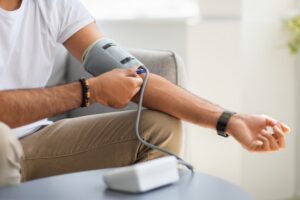The health risks associated with smoking are widely known, but many people don’t fully grasp the specific connection between smoking and vascular disease. Your vascular system, the vast network of blood vessels that carries blood throughout your body, is uniquely vulnerable to the toxic chemicals in cigarettes. To truly understand your risks of vascular disease with smoking, it’s important to look at how this habit directly damages your arteries and veins. This damage can lead to serious and life-threatening conditions. Quitting smoking is the single most effective step you can take to protect your vascular health, and a vascular health specialist can help you assess your current risk. Get a consultation with the best vascular disease specialists in Brooklyn.
How Smoking Directly Damages Your Vascular System
The thousands of chemicals in cigarette smoke, particularly nicotine and carbon monoxide, launch a direct assault on your blood vessels. This isn’t a slow, minor process; it’s a significant and immediate one that sets the stage for severe health problems.
Damage to the Endothelium
The inner lining of your arteries is a smooth, delicate layer called the endothelium. Its job is to keep blood flowing freely.
- Chemical Injury: Chemicals from smoke cause direct injury to the endothelial cells. This makes the artery walls rough and sticky.
- Plaque Buildup (Atherosclerosis): This sticky surface becomes a prime location for cholesterol, fat, and other substances to accumulate. This buildup, known as plaque, narrows and hardens the arteries, a condition called atherosclerosis. Atherosclerosis is a primary driver of most vascular diseases.
Constriction of Blood Vessels
Nicotine is a vasoconstrictor, meaning it causes your blood vessels to tighten and narrow. This has several negative effects:
- Increased Blood Pressure: Narrower vessels force your heart to pump harder to circulate blood, leading to high blood pressure (hypertension).
- Reduced Blood Flow: The constriction limits the amount of oxygen-rich blood that can reach your vital organs and extremities.
Thickening of the Blood
Smoking makes your blood thicker and more prone to clotting. It does this by increasing the activation of platelets, the blood cells responsible for clotting. This makes it more likely for dangerous blood clots to form within your arteries or veins.
Understanding Your Risks of Vascular Disease with Smoking
This damage translates into a significantly higher risk for several specific and serious vascular diseases. Smokers are far more likely than non-smokers to develop these conditions, often at a younger age.
Peripheral Artery Disease (PAD)
PAD occurs when the arteries that supply blood to your limbs, usually your legs, become narrowed by plaque.
- Symptoms: This can cause leg pain when walking (claudication), non-healing sores on the feet or legs, and an increased risk of amputation.
- The Smoking Link: Smoking is the single greatest risk factor for PAD. Smokers are up to four times more likely to develop it.
The carotid arteries supply blood to your brain. When plaque builds up in these arteries, it dramatically increases your risk of a stroke. The chemicals in smoke accelerate this plaque formation, and the increased risk of blood clots can lead to a blockage that starves the brain of oxygen.
Aortic Aneurysm
The aorta is the largest artery in your body. Smoking weakens the wall of the aorta, allowing it to bulge outwards like a balloon. This is called an aneurysm. If the aneurysm ruptures, it causes massive internal bleeding that is almost always fatal. Smokers are at a much higher risk of developing aortic aneurysms.
Buerger’s Disease
This is a rare disease strongly linked to tobacco use, where the blood vessels in the hands and feet become inflamed, swell, and can become blocked with clots. This can lead to pain, tissue damage, and eventually gangrene, requiring amputation of fingers or toes.
Taking Control of Your Vascular Health
The good news is that much of the damage from smoking can be halted, and your risk for vascular disease begins to decrease the moment you quit.
If you are a smoker, especially if you have other risk factors like diabetes, high blood pressure, or a family history of vascular disease, it is crucial to speak with a healthcare provider. A vascular health specialist can assess your individual risk profile, screen for existing disease, and provide guidance.
For individuals in the New York area, a vascular clinic in Brooklyn can offer comprehensive screenings, including simple, non-invasive tests like an ankle-brachial index (ABI) to check for PAD. Consulting with experts at a dedicated vascular clinic in Brooklyn provides you with a clear picture of your vascular health and a plan for protecting it.
Quitting smoking is the most powerful action you can take to prevent smoking and vascular disease. While quitting can be challenging, numerous resources, from counseling to nicotine replacement therapies, can help. Protecting your arteries is protecting your life, and it’s never too late to start. If you’re ready to take the next step, speak with your doctor or a specialist today. For any vascular problems, call us on + 1-718-367-2555. The Vascular Disease Specialists at Doral Health & Wellness consistently have outstanding patient satisfaction ratings. The professionals at Doral Health & Wellness Vascular Health Department Brooklyn can improve your health and quality of life because of their vast training and experience. New Yorkers can get the greatest medical and surgical vascular care at Doral Health & Wellness Brooklyn. If you need help, register your information and make direct contact with our doctors at https://yuz88hfiyh7.typeform.com/Doralintake or send an email to info@doralhw.org. Visit us at 1797 Pitkin Avenue, Brooklyn, NY 11212.






